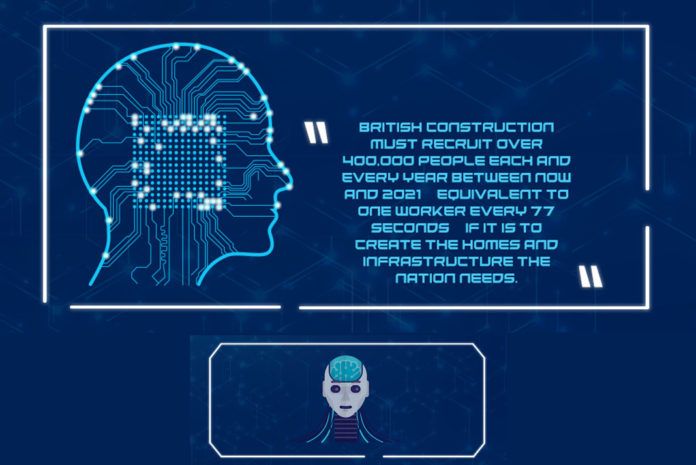
Jenny Turner, e-commerce manager at Powertools2U, talks to RCI about the future use of Artificial Intelligence and its impact on the construction industry
As with everything else, Artificial Intelligence (AI) is currently working its way into the construction sector and in particular when it comes to Roofing and the jury is out whether it’ll be off huge benefit or not.
Research by Powertools2U suggests that currently, there are three main areas where AI will be beneficial to the sector and one area where it’ll be a rather large negative.
Let’s start with the negative. Research suggests that 600,000 jobs could be lost from the current 2.2 million positions because of AI integration by 2040, with some calculating that the building site will be completely human-free by 2050. This hits home more when you look at the specifics. For example, labourers will be hit the hardest seeing their current number of employees dwindle from a healthy 127,220 to just 7,520. The same can be said for bricklayers (72,760 to 4,300), plasterers (47,500 to 2,810) roofers 43,830 to 2,590) and floorers (25,580 to 1,510) to name only a few, all seeing huge declines across the board, all predicted to happen in the next 20 years.
This will be down to the advancement in robotics. Machines such as shingling robots, which will impact on roofer numbers, are currently in advanced stages of production and can already drastically reduce both the time it takes to construct a house’s covering, as well as the obvious risk of injury involved with such a role. A similar situation will hit the bricklayers, with bricklaying robots that can build around five times as quick as the most efficient and experienced bricklayer could.
But what about the benefits of implementing AI onto the building site? The first of the benefits is the biggest and most important, safety. Implementing AI into the sector would drastically reduce the number of injuries on the building site, but it’ll do so in a way you may not have thought of initially. Yes, if robots are introduced in place of a human worker, then of course injury will be reduced, but what when AI is aiding man on the site? For example, body movement and form can be scanned and accessed by AI. This means that if a worker is using a tool or a piece of machinery incorrectly by having poor form, the AI can flag this and show the worker how to correct it. Another feature is being able to scan facial and object recognition. If a worker is not qualified to use a certain tool, the AI will signal this to security staff on-site, again preventing possible injury to someone who might not know exactly how to use a certain tool properly.
Not only will AI be able to prevent harm to workers on-site, it’ll also be able to reduce damage to the overall site too. Using its algorithms, it will be able to understand and also predict complex information, such as the weather. If it’s predicted to rain as an example, the AI will alert the site staff so factors such as potential water infiltration can be addressed before the weather arrives.
Finally, another good way that AI can be beneficial is by actually helping to design buildings rather than just aiding the building process. Artificial Intelligence can do this by answering questions that an architect would only be able to answer after extensive deliberation and assessment. The architect will soon be able to ask their clients a list of simple questions relating to how they would like their new space/building to look, function etc and then put this information into the AI system along with the physical requirements of the building. The algorithm will then produce several designs that fit to the clients’ requirements, saving the architect time.
So, what are your thoughts on the implementation of AI on the construction site. Is it a good or bad thing, or is it simply an inevitability?



